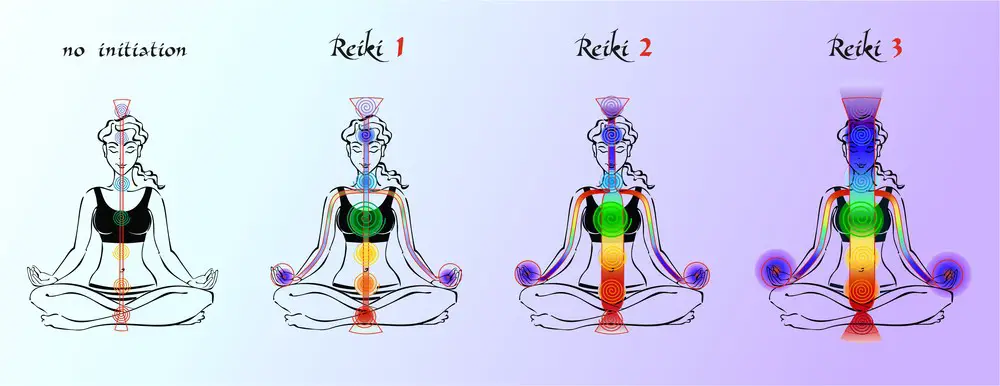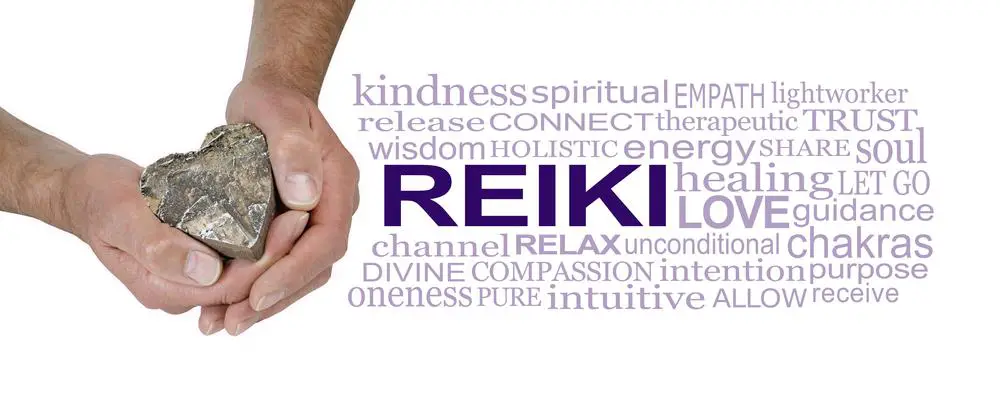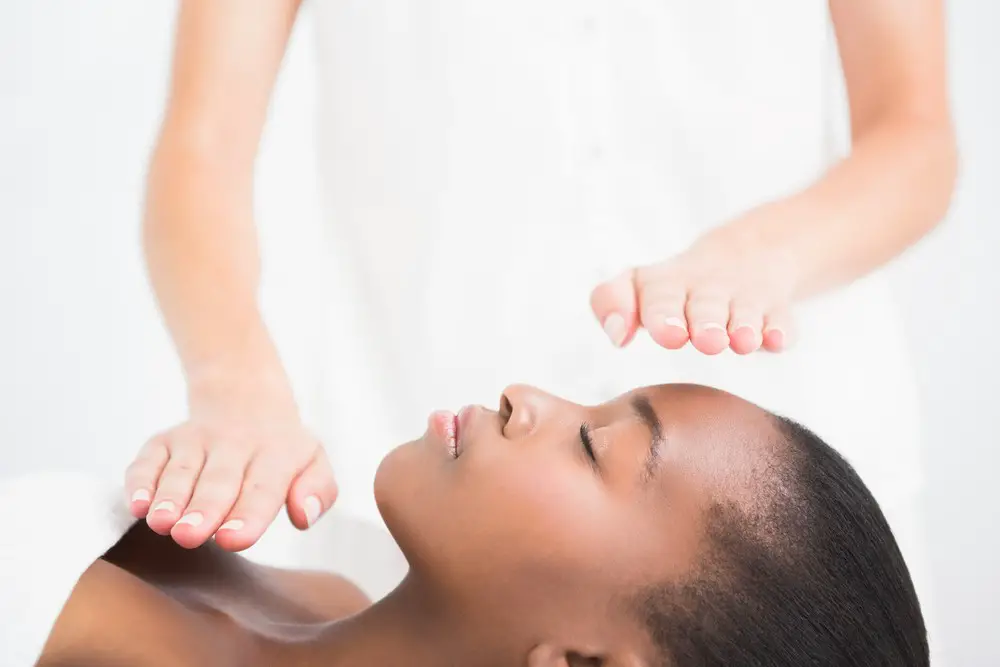As a BetterHelp affiliate, we receive compensation from BetterHelp if you purchase products or services through the links provided
Reiki, a form of energy healing originating from Japan, involves energy flow from a practitioner to a client to promote healing and well-being. At its core, Reiki seeks to balance out ki, which is the life force energy that flows through all of us. Oftentimes, Reiki is considered a spiritual practice, but it does not align with any specific sexual practices or connotations.
It’s important to understand that the goal of Reiki is to support healing in a non-invasive and gentle way. The Reiki session involves a practitioner placing their hands just above or lightly touching the body, focusing on transferring energy to help unblock or balance the client’s energy centers. Reiki can address various conditions, enhance well-being, and complement other therapeutic practices. This practice prioritizes comfort, safety, and respect between the practitioner and the client at all times.
As with any therapeutic practice, there may be misconceptions surrounding Reiki, particularly around its intentions and processes. Reiki is a therapeutic endeavor and holds no sexual agenda. It is administered with professionalism, and genuine practitioners adhere to strict ethical guidelines to foster a safe, secure environment for their clients.
Key Takeaways
- Reiki is a Japanese energy healing practice aimed at promoting well-being.
- The practice is non-invasive and maintains professional boundaries.
- Reiki’s purpose is therapeutic, not sexual, focusing on energy balance.
 Understanding Reiki
Understanding Reiki
Reiki is a form of energy medicine originating from Japan that focuses on spiritual healing. It is non-invasive and is often described as a practice that transfers universal energy from the practitioner’s palms to the patient.
History and Origins
Reiki was developed in the early 20th century by a Japanese Buddhist named Mikao Usui. After a period of meditation and fasting, Usui felt that he had received the ability to heal others without depleting his energy. This revelation marked the beginning of Reiki as a healing practice.
- Mikao Usui: Developer of Reiki
- Japan: Birthplace of Reiki
Key Takeaway: Reiki’s roots trace back to Mikao Usui in Japan, evolving as a spiritual healing practice.
Principles and Practices
At its core, Reiki revolves around five principles that guide the practice. These principles, often articulated in Japanese words, emphasize virtues such as peace, serenity, and an absence of worry and anger.
- Just for today, do not be angry.
- Just for today, do not worry.
- Just for today, be grateful.
- Just for today, work diligently.
- Just for today, be kind to others.
Reiki sessions typically involve the practitioner placing their hands on or near the body, intending to channel energy to promote healing and balance.
Key Takeaway: Embrace Reiki’s principles daily to guide you toward inner peace and balance.

Reiki Symbols and Meanings
Reiki symbols are integral to the practice and are used to focus energy. Understanding their meanings is essential for the practitioner.
- Cho Ku Rei (Power Symbol): Increases Reiki power; focuses energy
- Sei He Ki (Emotional/Mental Symbol): Brings emotional and mental balance
- Hon Sha Ze Sho Nen (Distance Symbol): Sends Reiki energy across time and space
- Dai Ko Myo (Master Symbol): Represents enlightenment and the most powerful healing energy
Each symbol is activated by drawing or visualizing it with the hand during a Reiki session.
Key Takeaway: Familiarizing yourself with Reiki symbols enhances the practice by harnessing specific energy forms for healing.
The Reiki Session
When you step into a Reiki session, the aim is to bring about deep relaxation and promote healing. The space is designed to make you feel at ease; the practitioner is there to guide the energy flow without any intrusive contact. Now, let’s walk through the steps of a Reiki Session.
Preparing for a Session
Before the session starts, your Reiki practitioner will typically briefly chat with you. This is to understand your needs and discuss what you hope to achieve. Here’s what you should expect:
- Wear comfortable clothes: You’ll remain fully clothed, so wear something loose and comfy.
- Setting the scene: The room may have soft lighting, calming music, or even fragrant aromas to help you relax.
Key Takeaway: Dress comfortably and be open about your needs and expectations.
During the Session
The core of the Reiki experience is here. During this time, you’ll likely be lying down on a massage table, and here’s what may take place:
- Physical touch: The practitioner’s hands hover above or lightly touch you, channeling energy to various parts of your body.
- Relaxation: As you relax deeply, you may feel warmth, tingling, or see colors – each person’s experience is unique.
Key Takeaway: Remain open to the experience, and allow yourself to relax as the practitioner works.
Post-Session Reflection
After your session, feeling a sense of calm and mindfulness is common. Here’s how you can reflect post-session:
- Sharing: Discuss any sensations or emotions that arose during the session; this can be valuable feedback for you and the practitioner.
- Integration: Give yourself some time to transition back to your day gently. Rushing out can jar the tranquility you just cultivated.
Key Takeaway: Embrace the peace from your session and carry it with you; reflect on your experience to fully integrate the benefits.

Benefits of Reiki
Reiki offers a range of health benefits that can enhance your physical, mental, and spiritual well-being. It’s designed to promote healing and bring a sense of balance to your life.
Physical and Emotional Health
- Healing & Pain: You may experience reduced physical discomfort and quicker recovery times.
- Emotional Pain: Techniques used in Reiki can aid in soothing emotional distress, easing conditions like:
- Anxiety
- Depression
Reiki is about alleviating symptoms and fostering an environment where the body can heal itself more effectively.
Key Takeaway: Reiki can help alleviate physical and emotional pain, improving overall health and relaxation.
Mental Clarity and Stress Reduction
- Stress & Anxiety: One of Reiki’s most celebrated benefits is its ability to help you let go of stress and anxiety, leading to a more peaceful state of mind.
- Depression: Regular sessions can improve your mood and may contribute to better handling of depressive symptoms.
By focusing on the body’s energy flow, Reiki encourages a natural state of balance, which can sharpen your mental focus and reduce feeling overwhelmed.
Key Takeaway: Implementing Reiki practices can clear your mind and significantly reduce stress.
Spiritual Growth and Balance
- Balance: You’ll find that regular Reiki sessions can restore a sense of energetic equilibrium, promoting harmony within.
- Relaxation: The deeply relaxing nature of Reiki makes it a perfect practice for those seeking a spiritual respite from the day-to-day hustle.
As a result, you may discover an enhanced connection to your inner self and a greater sense of purpose. Reiki invites you on a path of spiritual growth where balance is not just a concept but a lived experience.
Key Takeaway: Embrace Reiki to foster spiritual growth and achieve energetic balance.
 Reiki and the Body
Reiki and the Body
Reiki, a healing technique, works with the energy fields around and within your body. It aims to improve the flow and balance of your energy to support healing.
Energy Centers: Chakras
Your body houses central energy points known as chakras. These seven chakras correspond to different aspects of your physical and emotional well-being.
- Root Chakra: Associated with your sense of security and basic needs.
- Sacral Chakra: Relates to your creativity and sexual energy.
The alignment and balance of these chakras are crucial for maintaining overall health. Reiki practitioners often focus on these energy centers to enhance wellness.
Key Takeaway: Keeping your chakras balanced can contribute significantly to your sense of harmony and vitality.
Physical Healing
During Reiki, practitioners place their hands on or near your body, channeling energy to promote physical healing. Here’s how it can help:
- It’s believed to accelerate your body’s self-healing abilities.
- May reduce pain and inflammation.
- Aims to improve energy flow, which can eliminate blockages that often lead to illness.
Remember, while Reiki can be a complementary approach, it is not a substitute for medical treatment.
Key Takeaway: Reiki could support your body’s healing processes, but always consult with your healthcare provider.
Emotional Release
Your emotions can impact your body’s energy. Reiki has the potential to aid in releasing pent-up emotions, leading to:
- A feeling of emotional lightness by clearing the aura.
- Facilitating stress reduction and mental clarity.
When your emotional energy flows freely, you’re more likely to feel balanced and at peace.
Key Takeaway: Free-flowing emotional energy can enhance your overall sense of well-being.
Common Misconceptions About Reiki
Reiki is often surrounded by misconceptions that can lead to confusion. Let’s address this head-on to understand better what Reiki entails.
Sexual Energy and Boundaries
Sexual Energy: It’s a widespread myth that Reiki involves sexual energy or acts, but that’s not the case. Reiki is a form of energy healing, centered on the transfer of healing energy from practitioner to recipient through non-intrusive touch or just above the body.
- Boundaries: Safety and professional boundaries are fundamental in Reiki therapy. Practitioners adhere to a strict code of ethics to maintain a secure space. Communication is key, and your comfort should always come first.
Key Takeaway: Reiki is strictly a non-sexual therapy focused on your well-being, with clear boundaries to ensure a safe environment.
Reiki as Alternative Medicine
Reiki is recognized as an alternative medicine that supports but does not replace conventional medical treatment. It’s a complementary therapy, often used alongside other treatments to relieve stress and promote balance.
- Categorization: It falls under energy therapy and is geared towards holistic wellness.
- Effectiveness: It has been reported to help reduce anxiety and pain, but responses to Reiki can vary from person to person. Always approach it as an adjunct to medical advice, not a substitute.
Key Takeaway: Reiki is a complement to traditional treatments, designed to help with stress and pain management through energy balancing.
Reiki and Religion
The spiritual aspect of Reiki leads some to equate it with religious practice mistakenly. However, Reiki is not tied to any religion or spiritual belief. It is a spiritual practice related to the spirit or energy within and around us all.
- Inclusivity: It’s grounded in a universal energy concept, which allows individuals of all faiths, or none, to practice or receive Reiki.
- Personal Beliefs: Practitioners respect every individual’s personal beliefs. The purpose of Reiki is to promote healing and balance, not to propagate a religious ideology.
Key Takeaway: Reiki is a universal practice that honors individual spirituality without being rooted in any specific religious doctrine.
 The Role of a Reiki Practitioner
The Role of a Reiki Practitioner
As you explore the realm of Reiki, understanding the role of a practitioner is vital. These individuals serve as energy transfer conduits and pillars of trust and professionalism within their practice.
Conduit of Energy
A Reiki practitioner is fundamentally a channel. Your training and education have honed your ability to facilitate the flow of life force energy to your clients. This isn’t about creating energy; it’s about more effectively transferring what’s already there.
- Training: Extensive practice under qualified guidance.
- Techniques: Specific hand positions and symbols that optimize energy flow.
Key takeaway: Reiki practitioners are trained to serve as bridges between universal energy and the client, ensuring that energy flows in a balanced and beneficial way.
Ethics and Professionalism
Professionalism and ethics are cornerstones in your practice. Your actions are guided by codes that ensure safety, respect, and integrity. It’s not just about what you do, it’s about how you do it.
- Confidentiality: Keeping client’s details private.
- Boundaries: Maintaining appropriate physical and emotional boundaries.
Key takeaway: You are responsible for upholding the highest standards of ethics and professionalism, instilling confidence and security in your clients.
Building Trust with Clients
Trust is what turns a session into a therapeutic experience. You work to establish a connection with your clients that’s rooted in empathy and honesty.
- Consistency: Being reliable and consistent in your sessions.
- Openness: Encouraging communication and feedback to tailor the experience.
Key takeaway: Building a bond of trust is imperative in a Reiki practice. It’s the trust that you cultivate with clients that pave the way for true healing.
Reiki for Various Conditions
When you explore Reiki as a complementary approach to wellness, you’ll find that it’s applied to various health concerns. From chronic illnesses to emotional upheavals, Reiki might offer solace and support alongside traditional medical treatment.
Chronic Illnesses
- Cancer: Some individuals find Reiki beneficial as a supplemental therapy, providing a sense of relaxation and well-being during a taxing time.
- Diseases: Ongoing conditions like heart disease may benefit from Reiki by reducing stress and anxiety, which are common companions to such illnesses.
Key Takeaway: Reiki doesn’t cure these conditions but could ease your journey.
Acute Disorders
- Illnesses: Short-term afflictions, such as infections or flu, might improve comfort levels with Reiki sessions, promoting a sense of calm.
- Medical treatment: As you navigate the rigors of medical interventions, Reiki is a non-invasive addition to enhance recovery.
Key Takeaway: It’s all about balance; Reiki may help smooth out the rough patches of your acute health episodes.
Emotional Distress
- Depression: Engaging in Reiki might offer a gentle buffer against the weight of depression by cultivating an environment for emotional healing.
- Emotional pain and anxiety: By fostering relaxation, Reiki has the potential to alleviate feelings of anxiety and lighten your emotional burdens.
Key Takeaway: Let Reiki be a friend to your inner landscape, potentially bringing peace to where turmoil once resided.
Integrating Reiki with Other Therapies
Reiki, a form of energy work based on the teachings of Mikao Usui, often complements various therapies to enhance wellness. Here’s how you can combine Reiki with other stress reduction and healing practices.
Massage and Acupuncture
Massage:
- Encourages relaxation and tissue healing.
- When combined with Reiki: Enhances the therapeutic touch, potentially deepening relaxation responses.
Acupuncture:
- Targets specific points to balance your body’s energy.
- With Reiki: Aims to strengthen the body’s energetic harmony, possibly amplifying the benefits.
Key Takeaway: Combining Reiki with massage or acupuncture can potentially create a more profound experience in your journey towards balance and relaxation.
Yoga and Meditation
Yoga:
- Involves physical postures and breathing exercises.
- Reiki during Yoga: Can target energy flow as you hold poses, possibly supporting your focus and the synchronicity of movement and breath.
Meditation:
- A practice for training your mind in awareness.
- Infused with Reiki: Could deepen your meditative state, allowing for a more centered and tranquil experience.
Key Takeaway: Integrating Reiki with your yoga and meditation practices might help deepen the mind-body connection, fostering a more introspective and peaceful session.
Conventional Medical Treatments
In some hospitals and hospices, Reiki is introduced as a complementary therapy:
- Hospitals: Sometimes offer Reiki to help reduce patient stress and promote healing.
- Hospices: Use Reiki to comfort patients, potentially easing emotional and physical distress.
Key Takeaway: Acknowledging Reiki as a partner to conventional medical treatments can speak to its role in providing a holistic approach to care and wellbeing.
By exploring the synergy between Reiki and other therapeutic modalities, you might discover a richer,, more tailored path to health and wellness.
Learning and Training in Reiki
Understanding the educational pathway is crucial when ready to embark on your Reiki journey. You’ll go through attunement stages, find a guiding Reiki Master, and gather valuable resources before obtaining certification.
Levels of Attunement
In Reiki training, one progresses through three main levels of attunement, each unlocking new aspects of energy healing. Think of these levels as unlocking deeper layers of your healing potential.
- Level 1: The initial attunement process, where you’ll figure out how to channel Reiki energy for self-healing and begin understanding the practice’s fundamentals.
- Level 2: Here, you’ll learn to perform Reiki on others and start to use symbols and distance healing techniques.
- Level 3: Often called the Master Level, this attunement empowers you to teach and attune others to Reiki.
Key Takeaway: Each level of Reiki attunement elevates your understanding and capability to heal – for yourself and others.
Finding a Reiki Master
The relationship with a Reiki Master is an integral part of your training. They’re not just instructors but mentors who guide you through the attunement process and support your growth.
- Look for a Reiki Master you resonate with, as personal connection enhances the learning experience. Check their credentials and experience to ensure they’re well-qualified.
- Many Reiki Masters offer one-on-one sessions; however, group classes can offer camaraderie and a shared energy that may enrich your training experience.
Key Takeaway: Choosing the right Reiki Master contributes significantly to your success and growth in Reiki practice.
Resources and Certification
Self-education complements your practical Reiki training. Explore various resources such as:
- Books & eBooks: These can provide added insights into techniques and the history of Reiki.
- Online Courses: Convenient for those with busy schedules, online training can be a valuable tool, but ensure they offer a path to proper attunement.
Certification in Reiki varies depending on where and who you study with. Generally, to receive a certificate:
- Complete the required coursework.
- Demonstrate proficiency in Reiki.
- Fulfill any additional criteria set by your Reiki Master or the educational institution.
Key Takeaway: Use diverse resources to deepen your understanding of Reiki and ensure you fulfill all requirements to become a certified Reiki practitioner.
The Science and Research on Reiki
Reiki is an energy healing practice with a rich history, but when it comes to its scientific backing, you must understand where research and anecdotal accounts diverge.
Anecdotal Evidence versus Clinical Study
Anecdotal evidence abounds in Reiki, with many individuals reporting feelings of relaxation and emotional release. It’s comforting to hear these personal stories. Still, there’s a clear distinction between these accounts and clinical studies, which involve systematic methodologies and statistical analysis to validate the effectiveness of Reiki. Cutting through these personal narratives, researchers aim to assess Reiki’s impact on health and well-being objectively.
- Anecdotal Evidence: Personal, subjective reports; not systematically analyzed
- Clinical Studies: Systematically designed; generate statistically significant data
Key Takeaway: Trust but verify—while personal stories add a human touch, look for clinical studies for objective assessments.
Ongoing Research and Debates
While you may be seeking definitive answers, the nature of Reiki makes it a hotbed for debates within the scientific community. By its very nature, energy medicine challenges conventional medical paradigms; thus, research into Reiki is both ongoing and contentious. Some studies find potential benefits, while others see no significant effects beyond those of a placebo. This ongoing investigation is a reminder that science is never static but an evolving field fueled by inquiry and evidence.
- Current Debates: Efficacy of Reiki, mechanisms of action, integration into conventional medicine
- Ongoing Studies: Aim to address gaps in knowledge and build upon current understandings
The Placebo Effect
Understanding the placebo effect is crucial when evaluating Reiki. This phenomenon, where a person experiences a physiological reaction to a non-therapeutic intervention, can complicate study outcomes. The placebo effect demonstrates the complex interplay between mind and body, which is particularly relevant when examining practices like Reiki that involve the body’s energy systems.
- Placebo-controlled studies help isolate the treatment’s effects from psychological factors.
- Researchers strive to determine whether Reiki’s benefits stem from the treatment or placebo effect.
Key Takeaway: Stay curious—recognize the placebo effect’s role in any treatment evaluation, including Reiki.
Frequently Asked Questions
Understanding the intricacies of Reiki can help you make informed decisions about whether it’s a suitable form of therapy for you. Here, we’ll address some common inquiries about what to expect during a Reiki session.
What does a typical Reiki session involve with regard to physical contact?
A typical Reiki session usually includes light, non-invasive touch or the practitioner’s hands hovering just above your body. Physical contact is not sexual but intended to transfer energy and promote healing.
Key takeaway: Always communicate with your practitioner about touch preferences to ensure comfort.
Are there any specific groups of people who should avoid Reiki treatments?
Reiki is generally considered safe for most individuals. However, it’s best to consult with your healthcare provider if you have concerns due to a specific medical condition.
Key takeaway: Reiki can complement medical treatments, but never use it as a substitute for professional medical advice.
What sensations or experiences might one anticipate during a Reiki treatment?
During Reiki, you might feel warmth, tingling, relaxation, or even emotional release. Each person’s experience is unique, so there’s no one-size-fits-all expectation.
Key takeaway: Embrace your personal experience, as it will be distinct.
How does the practice of Reiki work on a person’s energy or well-being?
Reiki practitioners believe they channel universal energy to you, aiming to balance your energy flow, which can improve stress, pain, and well-being.
Key takeaway: The goal is harmony within your energy levels, potentially promoting overall wellness.
Is Reiki connected to intimacy or personal boundaries?
Reiki is not inherently intimate or sexual; it’s a respectful therapy that involves observing personal boundaries. Consistently articulate your boundaries and select a practitioner who honors them.
Key takeaway: A professional Reiki session will prioritize respect and personal comfort.
How does one ensure a safe and professional environment during a Reiki session?
To guarantee a professional experience, seek certified Reiki practitioners, clear communication about the process, and a comfortable, safe setting for your session.
Key takeaway: Choosing the right practitioner and environment is vital for a positive Reiki experience.
- Breaking the Silence: Why Men’s Mental Health Matters More Than Ever - April 15, 2025
- How to Transform a Home’s Patio Space into a Relaxing Space - March 23, 2025
- 5 Strategies to Use a Cell Phone to Help Manage Your Stress - March 23, 2025
This site contains affiliate links to products. We will receive a commission for purchases made through these links.


 Understanding Reiki
Understanding Reiki Reiki and the Body
Reiki and the Body
